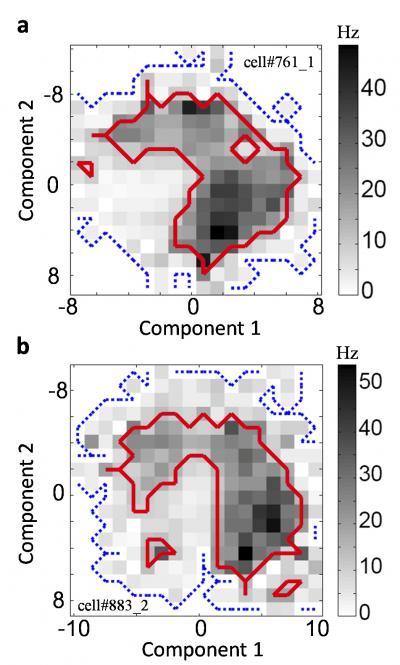For simple sensory events—like turning on a light, for example—the brightness correlates well with the spike probability in a luminance-sensitive cell in the retina. "However, over the last decade or so, it has become apparent that neurons actually encode information about several features at the same time," says graduate student and first author Jeffrey D. Fitzgerald.
"Up to this point, most of the work has been focused on identifying the features the cell responds to," he says. "The question of what kind of information about these features the cell is encoding had been ignored. The direct measurements of stimulus-response relationships often yielded weird shapes [see Figure 1, for example], and people didn't have a mathematical framework for analyzing it."
To overcome those limitations, Fitzgerald and colleagues developed a so-called minimal model of the nonlinear relationships of information processing systems by maximizing a quantity that is referred to as noise entropy. The latter describes the uncertainty about a neuron's probability to spike in response to a stimulus.
When Fitzgerald applied this approach to recordings of visual neurons probed with flickering movies, which co-author Lawrence Sincich and Jonathan Horton at the University of California, San Francisco, had made, he discovered that on average, first-order correlations accounted for 78 percent of the encoded information, while second-order correlations accounted for more than 92 percent. Thus, the brain received very little information about correlations that were higher than second order.
"Biological systems across all scales, from molecules to ecosystems, can all be considered information processors that detect important events in their environment and transform them into actionable information," says Sharpee. "We therefore hope that this way of 'focusing' the data by identifying maximally informative, critical stimulus-response relationships will be useful in other areas of systems biology."

This is an example of the flickering light stimulus presented during the experiment.
(Photo Credit: Movie: Courtesy of Dr. Tatyana Sharpee, Salk Institute for Biological Studies)

Spike distributions for neurons responding to two features can have shapes that are difficult to understand.
(Photo Credit: Image: Courtesy of Dr. Tatyana Sharpee, Salk Institute for Biological Studies)
Source: Salk Institute